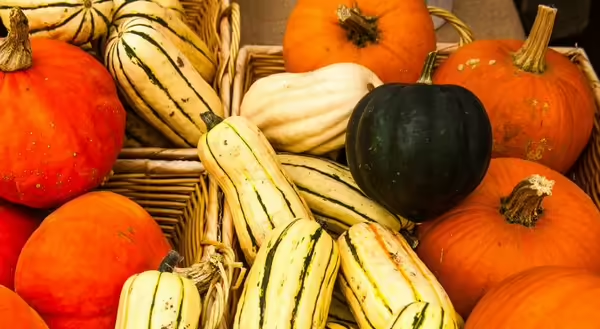
Imagine your last visit to a beloved family home, arriving as a freshly baked pumpkin pie was pulled from the oven. If you take a moment, I bet you can almost smell it.
Many people have this olfactory memory of the most well-known winter squash: the pie pumpkin. Others are also familiar with the smell or taste of pie pumpkin’s common cousins: spaghetti, acorn, and butternut squashes.
All belong to the gourd family, Cucurbitaceae, and thanks to amazing genetic potential, it houses hundreds of unique and delicious winter squash varieties.
What is winter squash, anyway?
Plainly put, it is a squash variety grown for storing and eating through winter’s leaner months. Winter squash has a hard outer skin that protects it during harvest and storage. As a result, they can be stored in a cool, dry location (like a basement) for several months, when properly cured.
Winter squash are cured by storing indoors for 10 days at a temperature of 80°F to 85°F and 80% to 85% humidity. Grocery store squash selections are cured before they are sold. When purchasing at a farmers market, ask the vendor if the squash has been cured.
Every year, many local growers allot some planting ground to lesser-known, but delicious winter squash. Sometimes this is a gamble. Winter squash requires extensive site preparation because it is a heavy feeder and occupies a large space.
On morning of a farmers market, every farm hand has completed an exhaustive ritual of lowering and lifting to harvest a truckload of squash whose sale depends on shoppers that day.
Explore these winter squash varieties
If you’re a squash-lover or a squash-discoverer, head to the market this weekend and purchase one of these delicious varieties for your next meal:
- Blue Hubbard – an amazingly sweet and flavorful pie substitute
- Delicata – sweet honey-like but also savory flavor
- Georgia Candy Roaster – reminiscent of a buttery sweet potato when cooked on its own
- Kabocha, green or red – a Japanese variety of winter squash that turns creamy when steamed
- Red Kuri – related to Kabocha with a chestnut-like, savory flavor when roasted
A new favorite in my family is Japanese squash, ‘Kabocha.’ With a ‘meat’ similar to sweet potato, it was destined to be great. Steamed for 15 minutes, this squash paired perfectly with leeks and curry seasoning.
Aside from delicious flavor and a hearty meal, a feast of winter squash is incredibly healthy.
“Winter squash ranks high on the nutritional list: it’s a good source of fiber and supplies a significant amount of potassium, vitamin A, and vitamin C.”
- Jenna Smith, University of Illinois Extension Nutrition and Wellness Educator.
This season, skip the pumpkin spice craze; start the cucurbit fan club for squash and pumpkin lovers because every pumpkin is a squash, but not every squash is a pumpkin!
Photo Credit: Squash And Pumpkins by Me in ME is licensed under CC BY 2.0.
ABOUT THE AUTHOR: Nick Frillman is a Local Foods and Small Farms Educator serving Livingston, McLean, and Woodford Counties. A fourth-generation graduate from University of Illinois, Frillman has a B.A. with a double major of Political Science and Spanish and a M.S. in Crop Science with a focus on crop production. Before joining Illinois Extension, Frillman completed a field season of CSA and farmers’ market-style production at a small “beyond-organic” vegetable farm in Sandy, Oregon.
ABOUT THE EDITOR: Liz Repplinger is the Agriculture and Natural Resources Program Coordinator serving Livingston, McLean, and Woodford Counties. A Bloomington-Normal native, Liz earned a B. A. in Animal Science and an M.S. in Animal Science from Illinois State University. She has enjoyed contributing to the multiple facets of Extension including previous support of the 4-H Youth Development Program as a program coordinator and current support of Unit and Statewide Diversity, Equity and Inclusion Initiatives.